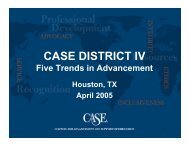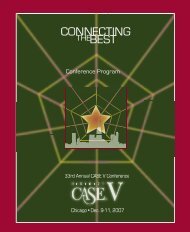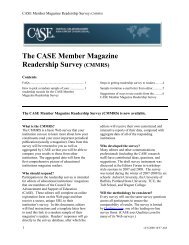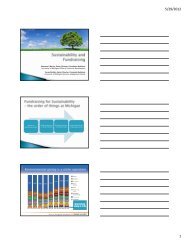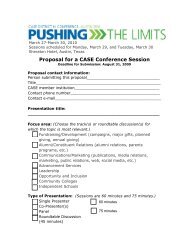You also want an ePaper? Increase the reach of your titles
YUMPU automatically turns print PDFs into web optimized ePapers that Google loves.
A Service Industry<br />
Into the breach step Feldman and his colleague, Robert B.<br />
Archibald, also a professor of economics at William and Mary.<br />
Their 2011 book Why Does <strong>College</strong> Cost So Much? takes a selfdescribed<br />
aerial view of the economics of higher education,<br />
explaining increased costs in the context of economic trends.<br />
They reject the damning “magnifying glass” look applied by some<br />
critics who, for example, equate the rising number of administrators<br />
with wayward inefficiency, and the variety of dining hall food<br />
choices with wretched excess. One of their goals is to cool down<br />
the raging rhetoric.<br />
An embrace from higher education “is not why we wrote the<br />
book,” Feldman said. “I have been thinking about these issues for<br />
a very long time now. We were surprised by the audience we got<br />
for our papers.” Not everyone is a fan. Those who criticize higher<br />
education also criticize Feldman and Archibald. “We’re picking<br />
darts out of our various body parts,” he said.<br />
Paying for the “big ticket item” of a college education is a<br />
“family decision … an ethical decision.” In his view, a college education<br />
is the best way to transfer wealth to children. The financial<br />
advantage is inarguable. In 2008, median annual earnings of men<br />
with a college degree reached $55,000; for men with just a high<br />
school diploma, that number was $32,000.<br />
And regardless of the public view about the expense of a college<br />
education, the Pew Research Center poll found that 94 percent of<br />
parents expect their children to attend college and 86 percent of<br />
college graduates believe their education was a good investment.<br />
<strong>Kenyon</strong> President S. Georgia Nugent pondered the paradox.<br />
“That’s the mood of the nation at the moment,” she said. “ ‘Higher<br />
education is doing a terrible job, and we want more access to it.’”<br />
Feldman believes a vocal minority has unleashed the aggression<br />
against higher education—those people “willing and able to<br />
scream the loudest,” including those who are paying the most at<br />
very expensive schools. He noted that half of the country’s college<br />
students face a tuition list price of less than $10,000 a year. And<br />
stories about some graduates leaving school with six-figure debt<br />
{<br />
<strong>College</strong>s must keep pace<br />
with technology, both in<br />
teaching and in the services<br />
that students expect.<br />
may be true but are, in fact, rare. “Making public policy on the<br />
basis of outliers is bad,” he said.<br />
The rising cost of higher education, Feldman said, can be<br />
attributed to the requirements of the digital age and accelerating<br />
technology; the growth of financial aid in the zeal to attract an<br />
accomplished and diverse enrollment; and the fact that colleges<br />
must maintain a highly educated work force.<br />
Improvements in technology have reduced costs for manufacturers<br />
but do not have the same effect in a “service industry” like<br />
higher education. Yet colleges must keep pace with technology,<br />
both in teaching and in the services that students expect. Science<br />
labs must be state-of-the-art. <strong>College</strong>s that wired campuses for<br />
the Internet have moved on to wireless technology. And, given<br />
the ubiquity of mobile telephones, land-line phones installed in<br />
residence-hall rooms face a phase-out.<br />
“We react to technology very differently than Ford or General<br />
Motors,” Feldman said. “We don’t adopt new technologies to<br />
lower cost. We have to shape the world our students are moving<br />
into.” When something new comes out, students expect it.<br />
The ramping up of financial aid, called discounting by<br />
Feldman, is a “big problem,” triggering an arms race among<br />
schools to attract the best and most diverse students. Higher<br />
tuition, along with a reliance on endowment revenue and philanthropy,<br />
helps cover the cost of financial aid. “I don’t know where<br />
the discounting is going to stop with the private [colleges].”<br />
The size of a college budget, Feldman said, is largely based on<br />
the quality of the program. If a college believes in the “supreme<br />
importance” of a diverse student body and is determined to<br />
provide discounts to reach that goal, the school may decide to<br />
hold the line on faculty salaries or not replace or hire a high-profile<br />
kenyon mandatory charges:<br />
(tuition, fees, room, board)<br />
1971-72 ..... $3,850 ($21,607 in 2011 dollars)<br />
1981-82 ..... $8,525 ($22,545)<br />
1991-92 ..... $19,425 ($32,397)<br />
2001-02 ..... $32,130 ($40,624)<br />
2011-12 ..... $52,650<br />
kenyon budget growth:<br />
1980-81 ..... $12,870,000 ($38,629,764 in 2011 dollars)<br />
1990-91 ..... $33,312,000 ($58,556,973)<br />
2000-01 ..... $56,189,000 ($73,459,589)<br />
2010-11 ..... $102,916,000





